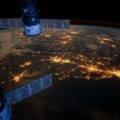New research examining the lakes of liquid methane and ethane on Saturn’s moon Titan reveals that they likely experience waves, which shape their coastlines through erosion just like water waves on Earth.
The existence of waves on Titan lakes has been hotly contested since NASA’s Cassini mission confirmed their presence back in 2007. However, no definitive evidence has proven their existence or lack thereof.
Now, a team of MIT geologists says their new models simulating the behaviour of Titan’s lakes, some of which are as large as Earth’s Great Lakes, not only have waves, but those waves have a significant eroding effect on the shape of the coastlines of those lakes, just like water waves on Earth.
“We can say, based on our results, that if the coastlines of Titan’s seas have eroded, waves are the most likely culprit,” explained Taylor Perron, the Cecil and Ida Green Professor of Earth, Atmospheric and Planetary Sciences at MIT. “If we could stand at the edge of one of Titan’s seas, we might see waves of liquid methane and ethane lapping on the shore and crashing on the coasts during storms. And they would be capable of eroding the material that the coast is made of.”
With their research published in the journal Science Advances, the scientists behind the new models say that Cassini’s confirmation of liquid lakes on Titan kicked off a heated debate on whether they were active like water lakes on Earth or almost perfectly smooth like a small pond.
“Some people who tried to see evidence for waves didn’t see any and said, ‘These seas are mirror-smooth,’” said the study’s first author, Rose Palermo, who is a former MIT-WHOI Joint Program graduate student and a research geologist at the U.S. Geological Survey. “Others said they did see some roughness on the liquid surface but weren’t sure if waves caused it.”
To see which was most likely without the time and cost of sending another probe into the depths of the solar system, the MIT researchers used models designed to simulate the activity of waves on Earth. Of course, they could not easily predict the actual waves themselves since such surface features are particularly elusive in imaging of Saturn’s moon Titan. However, the researchers say that their simulations offered them the opportunity to “take a different tack, and see, just by looking at the shape of the shoreline, if we could tell what’s been eroding the coasts.”
In those simulations, the team considered three distinct scenarios. In the first, they looked at how the coasts of the lakes would have been shaped if there had been no coastal erosion; in the second, they examined how they would be shaped by erosion driven by waves; and in the third, they simulated the possibility of uniform erosion, which was driven either by “dissolution,” in which a liquid passively dissolves a coast’s material, or another mechanism in which the coast gradually sloughs off under its own weight.
For the wave erosion models, the team had to simulate the “fetch” or distance between any two opposing points on a shoreline and then convert this data to the expected wave heights needed to cause the coastline shape actually observed by Cassini.
“Wave erosion is driven by the height and angle of the wave,” Palermo explains. “We used fetch to approximate wave height because the bigger the fetch, the longer the distance over which wind can blow and waves can grow.”
The same calculations were made using the “no-coastal erosion” models and the uniform erosion models. In particular, they focused on four of Titan’s largest, most well-mapped seas. This first, named Kraken Mare, is comparable in size to the Caspian Sea. The second, Ligeia Mare, is larger than Lake Superior, the third, Punga Mare, is longer than Lake Victoria, and the fourth, Ontario Lacus, is about 20 percent the size of Lake Ontario on Earth.
“We had the same starting shorelines, and we saw that you get a really different final shape under uniform erosion versus wave erosion,” Perron says. “They all kind of look like the flying spaghetti monster because of the flooded river valleys, but the two types of erosion produce very different endpoints.”
As expected, all three simulations resulted in a wide range of coastline shapes, with wave erosion the closest match by far. In fact, the team says that a direct comparison between the actual coastlines on Saturn’s moon Titan and those created by their wave erosion models “fit solidly,” showing that their modelled erosion patterns were an excellent match with the actual coastlines.
To check their results, the team compared their models to actual lakes on Earth. Sure enough, lakes whose coastlines are formed by either uniform erosion or wave erosion matched their models almost perfectly.
“We found that if the coastlines have eroded, their shapes are more consistent with erosion by waves than by uniform erosion or no erosion at all,” Perron says.
Next, the MIT team says they are modelling different wind velocities to determine how much atmospheric activity would be required to generate the wave heights needed to form the Titan lakes’ coastlines. They also hope to model the direction of the winds to better determine the mechanisms that shaped Titan’s coastlines.
“Titan presents this case of a completely untouched system,” Palermo says. “It could help us learn more fundamental things about how coasts erode without the influence of people, and maybe that can help us better manage our coastlines on Earth in the future.”
Christopher Plain is a Science Fiction and Fantasy novelist and Head Science Writer at The Debrief. Follow and connect with him on X, learn about his books at plainfiction.com, or email him directly at christopher@thedebrief.org.

